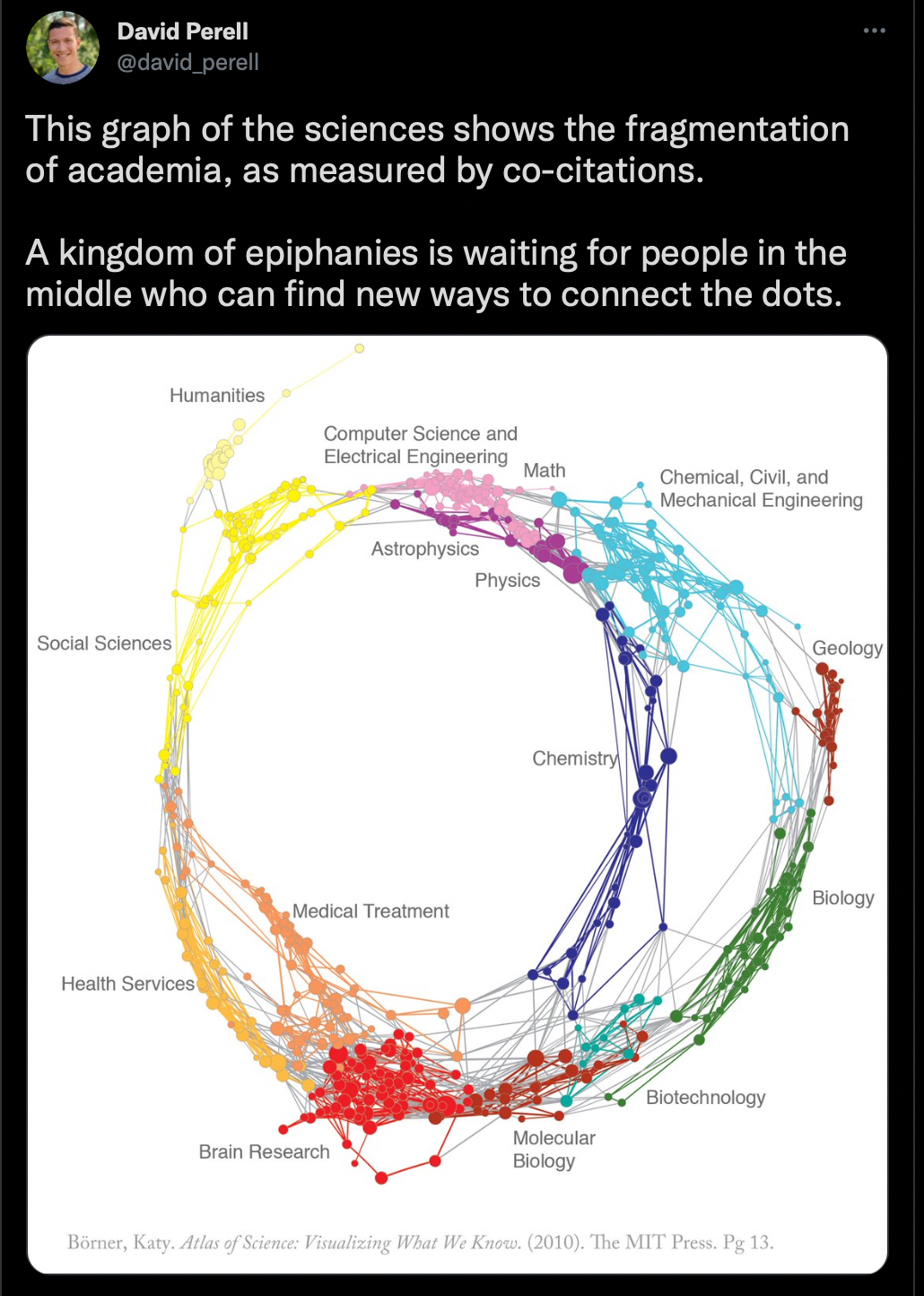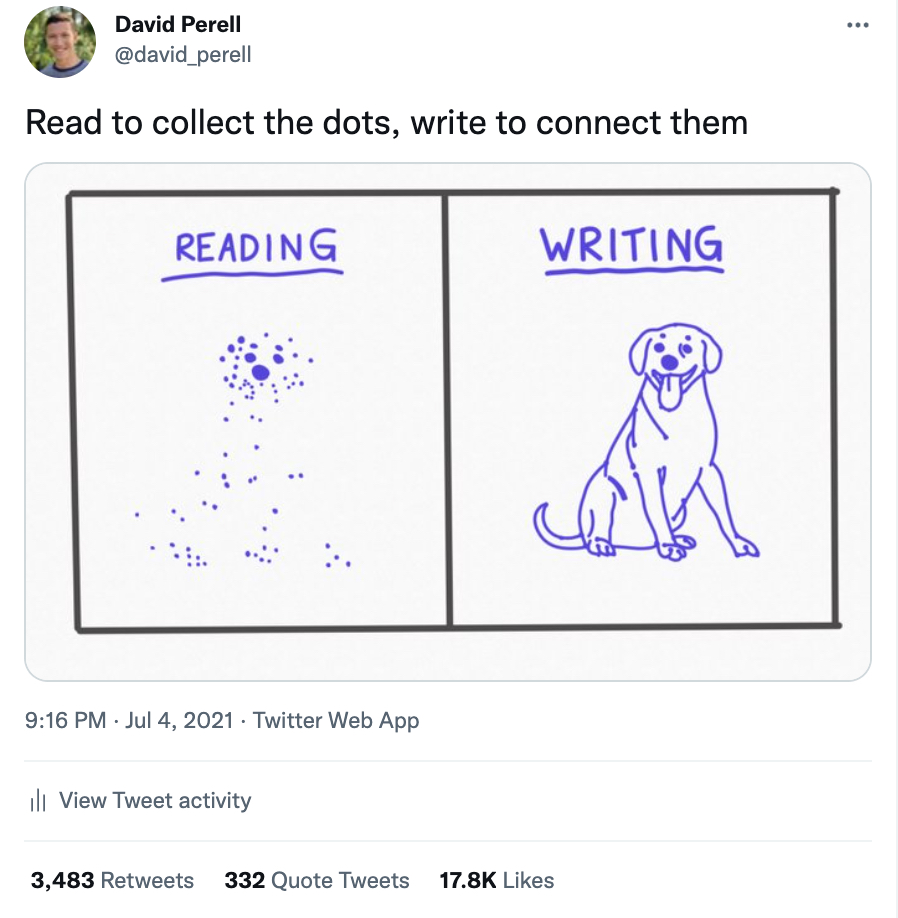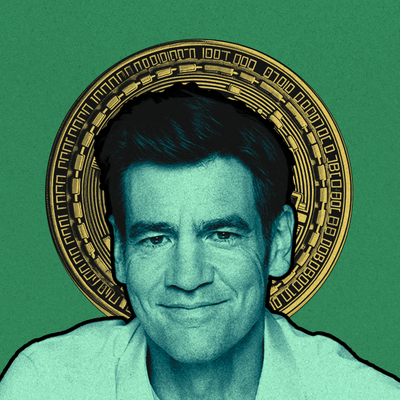
How do you find something interesting to write about? Or, put another way, how do you make your writing interesting? David Perell knows.
It’s an ingredient called surprise. He wraps it into each sentence of his essays. He gathers it by constant searching, and he searches by echolocation. He throws out his candidates in conversations, and on Twitter at a prodigious, unrestrained clip. He’s looking for ideas and ways of expressing them that raise eyebrows, that generate so many reactions they can’t be ignored. To truly find surprise, it turns out, you have to find it in someone else’s eyes.
If the internet is a Great Online Game, David Perell is one of its grand warlocks. He’s fashioned a career as “The Writing Guy”, writing essays, building a popular podcast, and creating the premier course on writing on the internet, Write of Passage.
He’s a small investor in Every, so of course, it should be said I have some reason to be impressed by him in this interview. But I’m trying not to write hagiography. There are, of course, other ways to write an essay. If you read this newsletter closely you’ll hear echoes of David’s system in the approaches of other writers like James Clear and Robin Sloan. But his recipe is totally his own, and native to the internet. There is much about it that I—we—can learn from.
In this interview we trace the birth of his mammoth essays from start to finish. We discuss how he gathers bits of surprise in his notetaking system, Evernote. They’re ideas from books he reads; they are sentences that will resonate; they are ways of framing that make you nod your head.
We hear how he tries them out in conversation—with friends, with students in his course, with random people he meets at parties. How he tweets them. Irreverently, intuitively, instinctually off-schedule, whatever comes to mind. And we see how the ones that stick and stand out, become his building blocks. When he sits down to write an essay, he has the raw ingredient of surprise at his fingertips, and his task is to harness it to express a larger idea.
Using surprise doesn’t mean the task of writing is easy. It is still difficult to find what he wants to say and discover how he wants to say it. To corral facts, and ideas, and frameworks into a coherent structure that has a beginning, middle, and end. His system for surprising sentences doesn’t make any of that a breeze. What it does is to create a palate for his writing that is built out of brighter flavors that can draw you into wanting more.
He says that when he writes he’s, “looking for the simplicity on the far side of complexity.” In this interview, we trace how he finds it. Let’s dive in!
David introduces himself
I'm David Perell, and I'm a writer, a podcast host, and the creator of a writing school called Write of Passage.
I use live conversation to cull and test out ideas
Before I write my essays, I talk through them live in conversation. As I talk, I pay attention to how people react. Are they confused? Bored? Or am I saying something insightful, or surprising?
These aren’t formal interactions that require structure or preparation. Instead I’m talking casually with people in my life whose judgment I trust. These are people I feel comfortable sparring with over a meal, on the phone when I’m out on a walk, or even on my podcast. It can be a family member, an old friend, a co-worker, or someone I meet at a dinner party where we just click. I devote a lot of time to cultivating these connections because they’re people who know how to push my thinking. And they usually exhibit two qualities: a sense for what’s interesting and an ability to ask revealing questions.
As I’m talking through my ideas with them, I’m listening for a few things in how they respond. I have an acronym for this to help me keep track: It’s called CRIBS, which stands for confusing, repeated, interesting, boring, and surprising. When an idea I throw out is confusing, repeated (like something I or someone else has said before), or boring, I move away from it and focus on other lines of thinking. When people find something I say interesting or surprising, I know to take that idea more seriously and dig deeper to get to what’s insightful or surprising. This habit has become so ingrained that often I don’t even notice I’m doing it—I’ve trained myself to have a heightened sense of awareness in conversation to how people react.
Paul Graham likes to say that an essay should meander toward surprise. I take that to heart in my writing, I try to build up surprise because surprise and insight and entertainment are all very tightly correlated. Surprise is also the fundamental axiom of Claude Shannon’s Information Theory. The more surprise is contained in a message, the more information it contains.
I use Twitter to validate ideas too
Twitter is another way for me to gauge people’s interest in ideas. Some writers are more measured in what they tweet and how they share their thinking. They might only share their own finished work, or other published pieces they find interesting. I’m more playful and experimental with my tweets. I throw out all kinds of tidbits that I or other people have thought up to see what resonates. It can be a quick chart, a drawing, or a simple writing tip I discover while sitting at the computer. The ideas behind the tweets may seem small or incomplete, but there is always a thread of insight that fits into my tapestry of ideas.
I pay a lot of attention to how people respond to these small snippets of insight—much more so than when I tweet a long piece I’ve just published that’s taken me months to complete. It’s nice to get feedback about my larger essays after the fact, but it does less to guide my thinking about new ideas on the horizon.
The snippets require less effort to produce, and I can see right away if they pop. When something really resonates, I might get hundreds of retweets, comments, and likes in a matter of minutes or hours. In some ways, that makes Twitter a more powerful feedback loop than what I get from live conversations. Talking through ideas generates a trickle of questions and reactions, one person at a time. On Twitter, the response to ideas is immediate and plentiful.
For example, I posted this graphic I’d found in my Evernote that explains the fragmentation of academia as measured by citations:
And when I posted it, it popped. It got like 500 retweets. And I said, “you know what I want to use this in some kind of future article—even though I don’t know what that’s going to be.”
It ended up being related to my People Driven Learning essay, and when I wrote it I put it right at the top. And that worked really well.
I write for 90 minutes every morning, before doing anything else
At some point during the process of filing away ideas, I’ll realize that I have more good information than I could ever possibly need about a topic to start writing. I usually have at least a sense of the essay I want to write, but the thought of actually putting the ideas on paper can be overwhelming. To overcome that feeling, I’ve established a pretty strict writing routine.
I’m juggling a lot of projects between writing, podcasting, and my course, so I have to be regimented and efficient with my time. I write first thing in the morning for 90 minutes each day, before I do anything else like opening email or checking social media. I don’t have a word count I’m shooting for. I just focus on filling the time with distraction-free writing. I like the Neil Gaiman line where he says: "I think it’s really just a solid rule for writers. You don’t have to write. You have permission to not write, but you don’t have permission to do anything else.” Once my 90-minute timer goes off, I can stop writing whenever I want.
I always write on the computer at my desk with a big monitor. In the early stages of writing, I listen to big room house music (I especially like the podcast Group Therapy) to inspire ideas and get me into flow. When I’m editing I’ll switch to more ambient music like deep house, which helps me relax and deepen my focus. And for the final stages of my writing, I never listen to music.
I usually work on about three to four essays at a time. That lends enough variety to my workload without spreading my efforts thin, which can be distracting and demotivating. I also have to be excited about what I’m writing. If I’m forcing myself to write, then the idea is probably incomplete or not that interesting. You can waste a lot of time aimlessly researching and writing about a topic you feel iffy about. People can tell when writers are uninspired. The words feel hollow and the sentences feel lame. No matter how much rewriting or editing you do to try to improve it, in the end it usually falls flat. Because of that, I don’t have a content schedule or anything like that. I just write what stirs my soul.
I start my essays by sorting my notes into building blocks to create logical flow
For me, the phase of finding and testing out ideas is easy. Figuring out what to do with them is hard—so hard that if I’m not extremely organized about my writing process, I’ll end up with a crippling case of writer’s block.
To avoid this, I break my writing into finite chunks that make my essays feel more manageable. Sometimes, I’ll start by creating an outline that I can dump all my notes into. I create sections based on themes I pull from scanning all the information I’ve collected.
I think of these sections as LEGO blocks. Each one is like a mini essay that I can address without having to think about the rest. One by one, I condense information, expand on ideas, and cut what doesn’t work in the block. As I’m working through each section, I discover and refine ideas that emerge and further my point.
When the blocks are all done I figure out how they fit together. Not all of them do. I think of this process as a little bit like playing sudoku. When you change one piece of the puzzle, you usually have to change the rest too. The whole puzzle needs to work together.
Usually I end up with blocks of text at the bottom of my outline that don’t fit the narrative. If I’m wedded to those blocks, I’ll take mental note of the structure I used and go back to talking it out with people. If the blocks still don’t fit when I test them out in conversation, I’ll often save them in Evernote for future use in another essay.
I can’t claim that organizing the writing into LEGO blocks is the best solution for every writer or genre of writing. I just know that if I don’t use them, I can’t get through the work. Knowing that the ideas in my first draft don’t need to fit together perfectly helps me put ideas on paper. Once they’re on the page, no matter how messy they are, I can shape them into something I’m proud of.
I use drawings to help distinguish my essays
Words aren’t the only way I express ideas. A lot of my essays feature drawings I create to capture essential points. The drawings have a particular style that helps distinguish the writing and elevate my thinking. Readers like them because they’re unusual and memorable.
I make these with an app called Concepts, and I create them on an iPad with an Apple Pencil. I pay attention to the colors I use to make each drawing recognizably mine. I use the same Purple (#5A44e4) to match the color of my website.
I want the drawings to look professional enough to show that I took some time on them, but playful enough to look human and relatable. I don’t want them to look too polished.
When I write, my goal is to synthesize complex thoughts simply and elegantly
For me, writing is about finding the simple in the confusing and the elegant in the complicated. Technology has put an endless amount of information at our fingertips—so much so that it’s hard to know what to absorb and pay attention to. Good writing is about solving that problem. It takes the burden off the reader’s shoulders by whittling the complex down to the essential.
This isn’t an easy thing to do. You aren’t aiming for superficial ideas—you are trying to convey complex ideas simply and elegantly. That means wrestling with all the good ideas that are already out there to arrive at real insight. You accomplish that by absorbing a ton of information and stirring on ideas until they speak to you.
That’s when I start thinking about compression. Pablo Picasso’s iconic “Bull” sketches are a perfect illustration of this. In his series of 11 lithographs, Picasso builds more and more detail into each sketch of his bull. So you see him expand on his own thinking. The first drawing is an intricate, realistic sketch of the bull. In the next two, he actually adds in more complexity. This is Picasso’s research phase.
As he sharpens the horns and adds shadow to the face, the bull becomes three-dimensional. Clearly he’s exploring possibilities and building on ideas. He’s shooting for more, not less. But there’s a point where he realizes it’s time to reverse course and rein the image in. He ends on a sparse but elegant rendering of the animal using just a few essential lines.
So where is that turning point for a writer? For me, it comes late in my research process, when my head is so full of information that the urge to write overpowers me. My ideas may not be fully formulated yet, but I need to get them down on the page to know how to refine them. This is what Oliver Wendell Holmes Jr. called the “simplicity on the far side of complexity.” I plow through several rounds of writing and editing to weed out all the excess and focus my thinking. When the rush of epiphany comes, I can’t help but write. It’s a magical feeling. It’s as if the idea becomes hyper-saturated while the rest of the world goes black-and-white. It’s a magical feeling. And hopefully, by the end of it all, I arrive at the essence of the bull.
Sharing my ideas creates a virtuous cycle of new connections and opportunities
When we reach that end—that essence of the bull—I’m always reminded of what draws me to this craft. It’s the intoxicating feeling of knowing that when you create a good piece of writing and share it in public, people will resonate with them. People worry a lot about the drawbacks of social media, but for a writer, its most salient feature is the ability to amplify good ideas. Under a long-time horizon, the Internet is quite a meritocracy. The best stuff spreads. The better the essay, the more people will read, share, and talk about it.
This is so different from the experience budding writers used to have when learning the craft in school. You’d spend years pouring your time and effort into writing for one person again and again: your teacher. That’s not nearly as exciting or rewarding as publishing your writing on the Internet. So I’m not surprised when I hear people say they don’t like to write.
I see my writing as a beacon for new connections, ideas, and opportunities. Almost all my closest friends are people I’ve met on the Internet. Reading somebody else’s writing is a great gauge of a person’s mind because it reveals how they think, what inspires them, and what they value.
Opportunities from writing crop up so often now that I’ve learned to think very carefully about which ones to pursue. I draw on Warren Buffett’s investing philosophy, which is to wait for the “fat pitch.” The stock market offers a world of enticing investment opportunities everyday, but you don’t want to jump on everything. Like a baseball player at the plate, you want to be selective about when you swing. When the right pitch comes, you should swing for the fences.
This post was co-written by Roya Wolverson.
Find Out What
Comes Next in Tech.
Start your free trial.
New ideas to help you build the future—in your inbox, every day. Trusted by over 75,000 readers.
SubscribeAlready have an account? Sign in
What's included?
-
Unlimited access to our daily essays by Dan Shipper and a roster of the best tech writers on the internet
-
Full access to an archive of hundreds of in-depth articles
-
-
Priority access and subscriber-only discounts to courses, events, and more
-
Ad-free experience
-
Access to our Discord community













Comments
Don't have an account? Sign up!